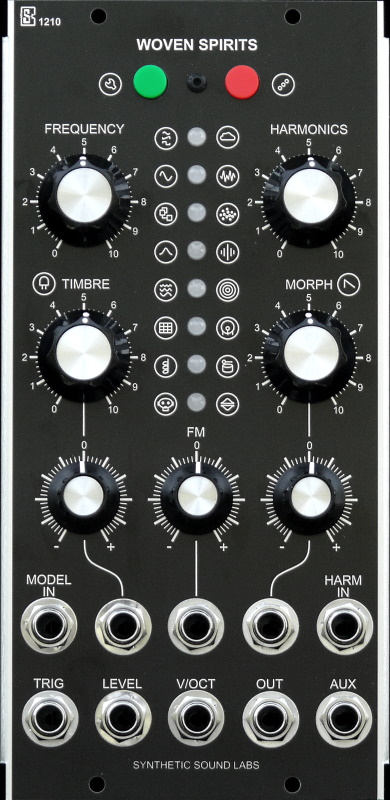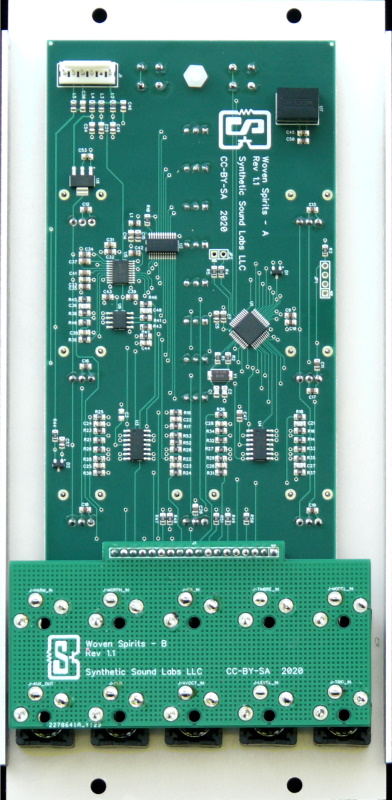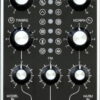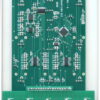Description
Woven Spirits is our MU version of Mutable Instruments’ Plaits – the spiritual successor of their best-selling voltage-controlled sound source, Braids. Not just a mkII version: its hardware and software have been redesigned from scratch.
Just like its predecessor, it offers direct access to a large palette of easily tweakable raw sonic material, covering the whole gamut of synthesis techniques.
SIMPLICITY FIRST
Gone are the screen, menu system, hidden settings, and the long list of somewhat redundant synthesis models.
Thanks to additional CV inputs, and to the use of three timbre-shaping parameters per model, Woven Spirits is straightforward to use, and much closer to the ideal of one synthesis technique = one model. What were fragmented islands of sound in Braids are now part of a continuum of sounds.
READY FOR PERCUSSION
Patch a trigger generator or sequencer into Woven Spirits’ trigger input and instantly use the module as a percussive source thanks to its built-in virtual low-pass gate (LPG).
An internal D (decay) envelope generator is normalled to all unpatched CV inputs. Just turn the corresponding attenuverter to add pitch, timbre or morphing modulation. And if plucks and snappy hits are not your thing, patch your own envelope or CV source into the LPG CV input.
6 deep synthesis models
8 synthesis models for pitched sounds
- Two detuned virtual analog oscillators with continuously variable waveforms.
- Variable slope triangle oscillator processed by a waveshaper and wavefolder.
- 2-operator FM with continuously variable feedback path.
- Two independently controllable formants modulated by a variable shape window (VOSIM, Pulsar, Grainlet, Casio CZ-style resonant filter…).
- 24-harmonic additive oscillator.
- Wavetable oscillator with four banks of 8×8 waves, with or without interpolation.
- Chord generator, with divide down string/organ emulation or wavetables.
- A collection of speech synthesis algorithms (formant filter, SAM, LPC), with phoneme control and formant shifting. Several banks of phonemes or segments of words are available.
8 synthesis models for noise and percussions
- Granular sawtooth or sine oscillator, with variable grain density, duration and frequency randomization.
- Clocked noise processed by a variable shape resonant filter.
- 8 layers of dust/particle noise processed by resonators or all-pass filters.
- Extended Karplus-Strong (aka Rings’ red mode), excited by bursts of white noise or dust noise.
- Modal resonator (aka Rings’ green mode), excited by a mallet or dust noise.
- Analog kick drum emulation (two flavors).
- Analog snare drum emulation (two flavors).
- Analog high-hat emulation (two flavors).
Dual output
- The AUX output carries a variant, sidekick or by-product of the main signal.
- Patch both OUT and AUX to Warps for weird hybridization experiments!
- Dedicated CV input for synthesis model selection. No need to activate a mysterious
METAmode! - An internal decay envelope is normalled to the TIMBRE, FM and MORPH CV inputs: the amount of internal modulation is directly adjusted with the attenuverters.
Internal low-pass gate (LPG)
- Dedicated LEVEL CV input controlling the amplitude and brightness of the output signal.
- The internal LPG can also be directly plucked by the trigger input.
- Two parameters of the LPG can be adjusted: amount of low-pass filtering (VCFA to VCA), and response time of the virtual vactrol.










Reviews
There are no reviews yet